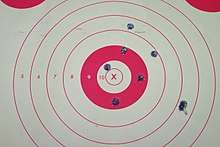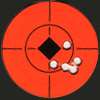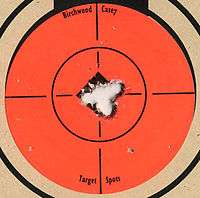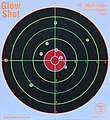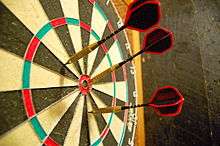Shooting target
Shooting targets are objects in various forms and shapes that are used for pistol, rifle, shotgun and other shooting sports, as well as in darts, target archery, crossbow shooting and other non-firearm related sports. The center is often called the bullseye. Targets can for instance be made of paper, "self healing" rubber or steel. There are also electronic targets that electronically can provide the shooter with precise feedback of the shot placement.
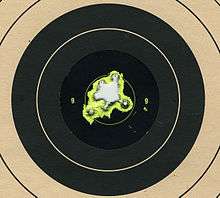

History
Most targets used in shooting sports today are abstract figures of which origins often are not given much thought, but given the military and hunting origins that started most shooting disciplines it is not hard to understand that many of the targets at some point originally resembled either human opponents in a battle or animals in a hunting situation. For instance, the well known circular bullseye target might originally have resembled a human torso or an animal being hunted. Notable instances of shooting targets with martial origins which are considered abstract today, are the field targets used in Det frivillige Skyttervesen where the original intent was to resemble amongst other wheels of vehicles (S25 target), barrels (tønne), bunker openings (stripe 30/10 and 13/40) or enemy personnel (1/3, 1/4, 1/6 and 1/10 figure, minismåen, etc.). The origin of these targets are not usually given much attention (or is even known by most shooters), and have been kept around for variation and tradition.
Types of targets
by Action
- Stationary/static target
- Dynamic target
- Running target - target is moving sideways (examples are defunct disciplines 100 metre running deer, 10 meter running target...)
- Moving target (example is defunct discipline moving target small-bore rifle)
- Disappearing target (example is defunct discipline disappearing target small-bore rifle)
- Flying target (used in skeet, trap, double trap)
by Reactivity
- Non-reactive, ordinary paper target
- Reactive — reactive targets are designed to move and/or bounce along the ground when hit. Reactive targets are often used for plinking, which refers to casual shooting practices aiming at informal target objects such as tin cans, glass bottles, steel barrels/plates, or anything else that draws the shooter's attention.
- "Splatter" target — paper targets (often black in color) with dual-laminations separated by a plastic film, which shrivel and expose the brighter-colored underlayer to generate high-contrast jagged halos around the impact holes, allowing easier observation from distance
- Steel targets — generate audible sounds and (sometimes) movements when hit
- Explosive targets — binary explosive-loaded containers (e.g. Tannerite) that are designed to detonate when punctured by a bullet traveling with sufficient terminal energy
- Interactive - various targets are displayed on a bullet-proof screen that capture the impacts. The impacts are visible on the target screen and on the remote monitor via an electronic scoring system.
 A Cabela's branded "Self healing ground bouncing reactive" target
A Cabela's branded "Self healing ground bouncing reactive" target Drum
Drum
by Material
- Steel targets - metal silhouettes
- Paper or cardboard
- Foam - used in 3D archery
- Frangible (such as clay or tiles)
- Self-healing rubber target
- Electronic
- Explosive - Targets are designed to explode when stuck with a bullet traveling at a suitable velocity to induce detonation.
 Exploding target detonation
Exploding target detonation Exploding target detonation
Exploding target detonation
by Realism
- 2D
- 3D - usually models of real life animals in archery.
by Color
Mostly important for paper targets.
- yellow, red, blue, black and white rings
- yellow, red and blue rings
- yellow and black rings
- white and black rings
- ...
Archery sports
World Archery Federation
FITA targets are used in archery shooting competitions within the World Archery Federation. The targets have 10 evenly spaced concentric rings, generally with score values from 1 through 10. In addition there is an inner 10 ring, sometimes called the X ring. This becomes the 10 ring at indoor compound competitions, while outdoors, it serves as a tiebreaker with the archer scoring the most X's winning. The number of hits may also be taken into account as another tiebreaker. In FITA archery, targets are coloured as follows:
- 1 & 2 ring: White
- 3 & 4 ring: Black
- 5 & 6 ring: Blue
- 7 & 8 ring: Red
- 9, 10 & inner 10 (X) ring: Gold
 The FITA target is used in target archery by the World Archery Federation.
The FITA target is used in target archery by the World Archery Federation.
3D archery targets
3D targets are life-size models of game used in field archery.
 A coyote "3D target".
A coyote "3D target".
Firearm sports
Air rifle field targets
In the outdoor air gun discipline field target metal targets of various shape and forms are used. The metal plates are often shaped to resemble small game animals, although there is currently a move towards simple geometric shapes.
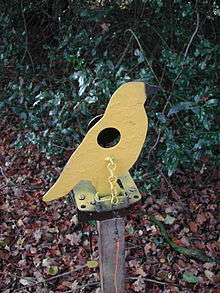 A crow-shaped, knock-over metal air gun field target. The black painted metal paddle must be hit to make the target fall over, and the target can be reset by pulling the orange cord attached to the face-plate.
A crow-shaped, knock-over metal air gun field target. The black painted metal paddle must be hit to make the target fall over, and the target can be reset by pulling the orange cord attached to the face-plate. Another crow-shaped, knock-over metal air gun field target. The black painted metal paddle must be hit to make the target fall over, and the target can be reset by pulling the orange cord attached to the face-plate
Another crow-shaped, knock-over metal air gun field target. The black painted metal paddle must be hit to make the target fall over, and the target can be reset by pulling the orange cord attached to the face-plate A rat knock-over metal air gun field target.
A rat knock-over metal air gun field target.
Clay pigeons
Clay pigeon targets are usually used as flying targets for clay pigeon shooting, formally known as Inanimate Bird Shooting.
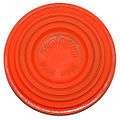 A 10 centimetres (4 in) clay pigeon.
A 10 centimetres (4 in) clay pigeon. Clay pigeon throwing machine.
Clay pigeon throwing machine.
International Confederation of Fullbore Rifle Associations
In fullbore target rifle within the International Confederation of Fullbore Rifle Associations (ICFRA), competitions can be held in either a short range or long range format, with distances either in yards or meters. F-Class shoots at the same targets as Palma, but during the scoring process an extra inner ring (which is half the diameter of the V-bull) counts only for F-Class. While short range is shot at a different target size for each of the six distances, long range is shot at the one and same type of target at different distances.[2] Below are the official target sizes, and approximate subtensions in milliradians and arcminutes depending on distance.
- Metric ICFRA International Match Targets and F-Class Targets (Short Range)
- at metric distances:
| (image missing) | (image missing) | (image missing) | (image missing) | |||||
|---|---|---|---|---|---|---|---|---|
| 300 m | 400 m | 500 m | 600 m | |||||
| Subtension | Angular size | Subtension | Angular size | Subtension | Angular size | Subtension | Angular size | |
| Aiming Mark | 600 mm | 2.0 mrad | 800 mm | 2.0 mrad | 1000 mm | 2.0 mrad | 1000 mm | 1.7 mrad |
| Extra inner ring (F-Class only) |
35 mm | 0.1 mrad | 47.5 mm | 0.1 mrad | 72.5 mm | 0.1 mrad | 80 mm | 0.1 mrad |
| V-Bull | 70 mm | 0.2 mrad | 95 mm | 0.2 mrad | 145 mm | 0.3 mrad | 160 mm | 0.3 mrad |
| Bull | 140 mm | 0.5 mrad | 185 mm | 0.5 mrad | 290 mm | 0.6 mrad | 320 mm | 0.5 mrad |
| Inner | 280 mm | 0.9 mrad | 375 mm | 0.9 mrad | 660 mm | 1.3 mrad | 660 mm | 1.1 mrad |
| Magpie | 420 mm | 1.4 mrad | 560 mm | 1.4 mrad | 1000 mm | 2.0 mrad | 1000 mm | 1.7 mrad |
| Outer | 600 mm | 2.0 mrad | 800 mm | 2.0 mrad | 1320 mm | 2.6 mrad | 1320 mm | 2.2 mrad |
- Metric ICFRA International Match Targets and F-Class Targets (Short Range)
- at imperial distances:
| (image missing) | (image missing) | (image missing) | (image missing) | |||||
|---|---|---|---|---|---|---|---|---|
| 300 yds | 400 yds | 500 yds | 600 yds | |||||
| Subtension | Angular size | Subtension | Angular size | Subtension | Angular size | Subtension | Angular size | |
| Aiming Mark | 560 mm | 7.02 moa | 745 mm | 7.00 moa | 915 mm | 6.88 moa | 915 mm | 5.73 moa |
| Extra inner ring (F-Class only) |
32.5 mm | 0.41 moa | 42.5 mm | 0.40 moa | 65 mm | 0.49 moa | 72.5 mm | 0.45 moa |
| V-Bull | 65 mm | 0.81 moa | 85 mm | 0.80 moa | 130 mm | 0.98 moa | 145 mm | 0.91 moa |
| Bull | 130 mm | 1.63 moa | 175 mm | 1.64 moa | 260 mm | 1.95 moa | 290 mm | 1.82 moa |
| Inner | 260 mm | 3.26 moa | 350 mm | 3.29 moa | 600 mm | 4.51 moa | 600 mm | 3.76 moa |
| Magpie | 390 mm | 4.89 moa | 520 mm | 4.89 moa | 915 mm | 6.88 moa | 915 mm | 5.73 moa |
| Outer | 560 mm | 7.02 moa | 745 mm | 7.00 moa | 1320 mm | 9.93 moa | 1320 mm | 8.27 moa |
- The Metric ICFRA International Match Target and F-Class Target (Long Range)
- at metric and imperial distances:
| (image missing) | |||||||
|---|---|---|---|---|---|---|---|
| Subtension | Angular sizes | ||||||
| 700 m | 800 yds 731.52 m |
800 m | 900 yds 822.96 m |
900 m | 1000 yds 914.4 m | ||
| Aiming Mark | 1120 mm | 1.6 mrad | 1.5 mrad | 1.4 mrad | 1.4 mrad | 1.2 mrad | 1.2 mrad |
| Extra inner ring (F-Class only) |
128 mm | 0.18 mrad | 0.18 mrad | 0.16 mrad | 0.16 mrad | 0.14 mrad | 0.14 mrad |
| V-Bull | 255 mm | 0.4 mrad | 0.3 mrad | 0.3 mrad | 0.3 mrad | 0.3 mrad | 0.3 mrad |
| Bull | 510 mm | 0.7 mrad | 0.7 mrad | 0.6 mrad | 0.6 mrad | 0.6 mrad | 0.6 mrad |
| Inner | 815 mm | 1.2 mrad | 1.1 mrad | 1.0 mrad | 1.0 mrad | 0.9 mrad | 0.9 mrad |
| Magpie | 1120 mm | 1.6 mrad | 1.5 mrad | 1.4 mrad | 1.4 mrad | 1.2 mrad | 1.2 mrad |
| Outer | 1830 mm | 2.6 mrad | 2.5 mrad | 2.3 mrad | 2.2 mrad | 2.0 mrad | 2.0 mrad |
International Practical Shooting Confederation
In matches organized by the International Practical Shooting Confederation, both steel and paper targets are used. Currently the only paper targets used for handgun is the IPSC Target (formerly Classic Target) and the 2/3 scaled down IPSC Mini Target (formerly IPSC Mini Classic Target). The center of these paper targets is called the A-zone. Additionally, for rifle and shotgun "A3" and "A4" paper targets and the "Universal Target" is used. For steel targets, standardized knock down targets called "poppers" are used. The two approved designs are the full size "IPSC Popper" (formerly IPSC Classic Popper) and the 2/3 scaled down version "IPSC Mini Popper" (formerly "IPSC Classic Mini Popper"), while the Pepper Popper and Mini Pepper Popper is now obsolete.
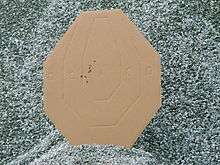 The octagonal IPSC Target (formerly known as the Classic Target) is a cardboard target used in all disciplines within the International Practical Shooting Confederation.
The octagonal IPSC Target (formerly known as the Classic Target) is a cardboard target used in all disciplines within the International Practical Shooting Confederation.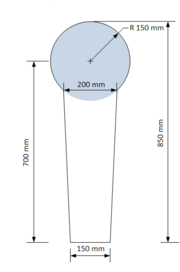 The full size IPSC Popper (formerly known as the Classic Popper).
The full size IPSC Popper (formerly known as the Classic Popper). IPSC Mini Popper (formerly known as Classic Mini Popper), a 2/3 scaled down version of the IPSC Popper used to simulate greater distance.
IPSC Mini Popper (formerly known as Classic Mini Popper), a 2/3 scaled down version of the IPSC Popper used to simulate greater distance. Pepper Popper, no longer used in IPSC competitions.
Pepper Popper, no longer used in IPSC competitions. Mini Pepper Popper, no longer used in IPSC competitions.
Mini Pepper Popper, no longer used in IPSC competitions.
International Shooting Sport Federation
Within the International Shooting Sport Federation mostly various bullseye targets are used, with variances depending on disciplines. For shotgun clay targets are used.
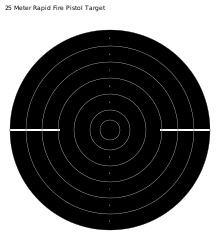 |
 |
 |
 | |||||
|---|---|---|---|---|---|---|---|---|
| 25 m Rapid Fire Pistol | 25 m Precision Pistol | 50 Meter Pistol | 10 Meter Air Pistol | |||||
| Subtension | Angular size | Subtension | Angular size | Subtension | Angular size | Subtension | Angular size | |
| Inner Ten | 50 mm | 2 mrad | 25 mm | 1 mrad | 25 mm | 0.5 mrad | 5 mm | 0.5 mrad |
| 10 Ring | 100 mm | 4 mrad | 50 mm | 2 mrad | 50 mm | 1 mrad | 11.5 mm | 1.15 mrad |
| Subsequent Ring Increase |
80 mm | 3.2 mrad | 50 mm | 2 mrad | 50 mm | 1 mrad | 16 mm | 1.6 mrad |
| Aiming mark | 500 mm | 20 mrad | 200 mm | 8 mrad | 200 mm | 4 mrad | 59.5 mm | 5.95 mrad |
| (image missing) | 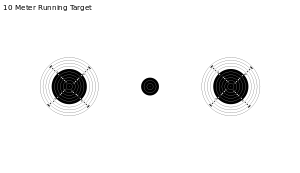 | |||
|---|---|---|---|---|
| 50 m Running Target (Rifle) | 10 m Running Target (Rifle) | |||
| Subtension | Angular size | Subtension | Angular size | |
| Inner Ten | 30 mm | 0.6 mrad | 0.5 mm | 0.05 mrad |
| 10 Ring | 60 mm | 1.2 mrad | 5.5 mm | 0.55 mrad |
| Subsequent Ring Increase |
34 mm | 0.68 mrad | 5 mm | 0.5 mrad |
| Aiming mark | 30.5 mm | 3.05 mrad | ||
 |
 |
 | ||||
|---|---|---|---|---|---|---|
| 300 m Rifle | 50 m Rifle | 10 m Air Rifle | ||||
| Subtension | Angular size | Subtension | Angular size | Subtension | Angular size | |
| Inner Ten | 50 mm | 1/6 mrad ≈ 0.167 mrad | 5 mm | 0.1 mrad | (Determined by scoring gauge) | - |
| 10 Ring | 100 mm | 1/3 mrad ≈ 0.33 mrad | 10.4 mm | 0.208 mrad | 0.5 mm | 0.05 mrad |
| Subsequent Ring Increase |
100 mm | 1/3 mrad ≈ 0.33 mrad | 16 mm | 0.32 mrad | 5 mm | 0.5 mrad |
| Aiming mark | 600 mm | 2 mrad | ≈ 95.7 mm | ≈ 1.9 mrad | 25.5 | 2.55 mrad |
Metallic silhouette
In metallic silhouette shooting only knock down steel targets featuring animals are used.
 Metallic silhouette targets featuring a chicken, pig, turkey and ram, scaled to appear as they would if placed at the correct distances from the shooter. Scale in minutes of angle, correct for NRA high power rifle using yards.
Metallic silhouette targets featuring a chicken, pig, turkey and ram, scaled to appear as they would if placed at the correct distances from the shooter. Scale in minutes of angle, correct for NRA high power rifle using yards..jpg) A Hunter Field Target (HFT) metallic target in the form of a Rat.
A Hunter Field Target (HFT) metallic target in the form of a Rat.
Popinjays
The Popinjay (from the French papegai, or "parrot") is an ancient form of target for crossbow shooting. Originally a bird tethered in a tree, it developed into a complex painted wood target atop a tall wooden pole. The popinjay would form the centrepiece of a major shooting contest and many shooters would try their skill repeatedly against the same target. Scoring was awarded for shooting off various parts of the target.
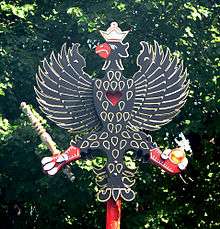 A Popinjay target used for Adler shooting during the 2010 Rutenfest Ravensburg festival in Germany
A Popinjay target used for Adler shooting during the 2010 Rutenfest Ravensburg festival in Germany
Human silhouette
Human silhouette targets are use for military, police and civilian firearms training.
- NATO E-type Silhouette Target
 Human silhouette target
Human silhouette target- A digital target range at the firearms training simulator on Kunsan Air Base waits to be used.
 Swiss military targets
Swiss military targets_140403-M-MX805-097_(13659746275).jpg)


_2_Swift_fires_an_M9_during_weapons_qualification_on_the_fantail.jpg)
.jpg)

Mannequins
Mannequins are sold for use as practice targets. Examples include The Ex, which resembles a woman, and another resembling former United States President Barack Obama.
See also
- Electronic target
- Shot grouping
- Scoring gauge
- Steel target
